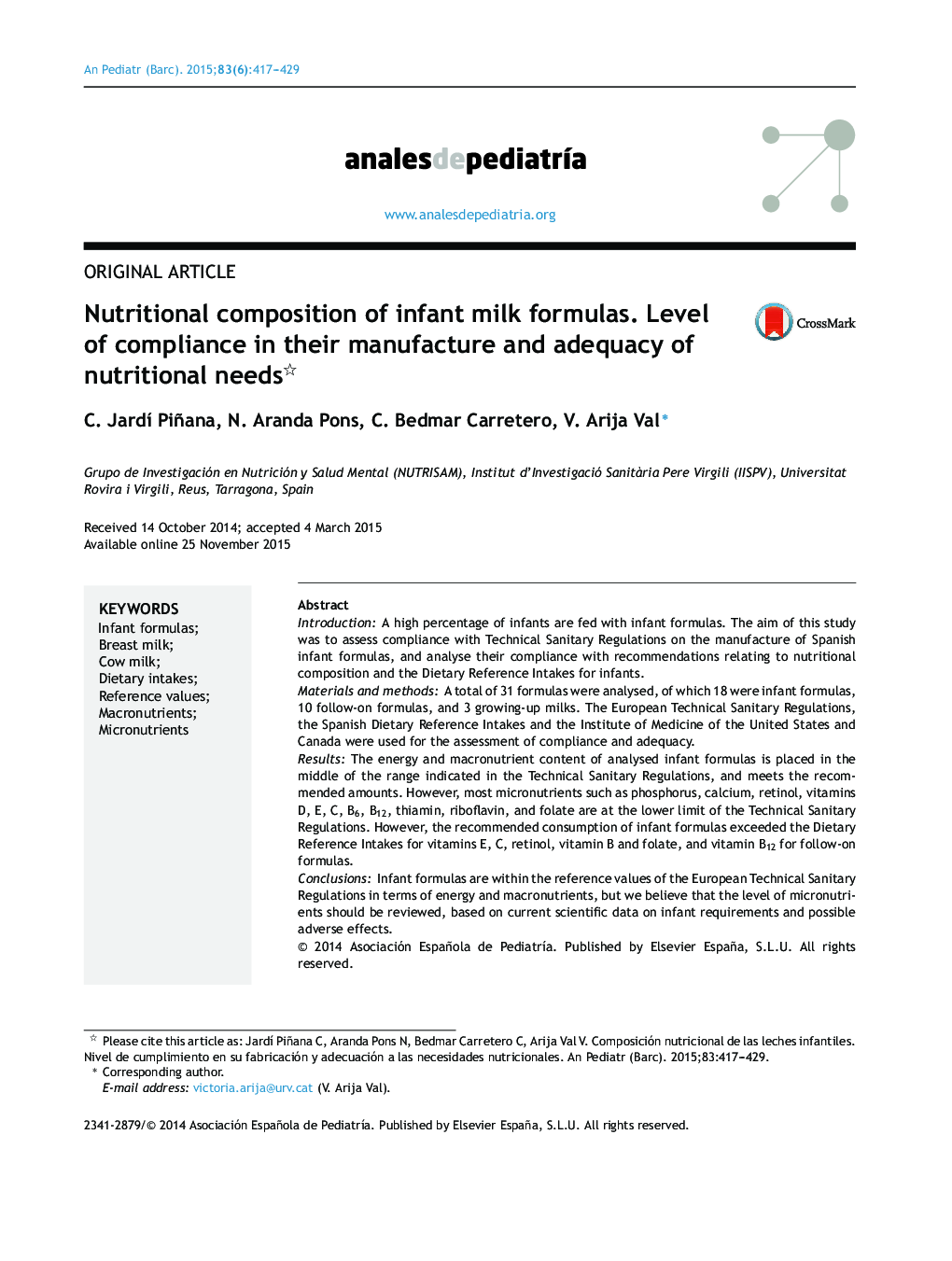| Article ID | Journal | Published Year | Pages | File Type |
|---|---|---|---|---|
| 4145167 | Anales de Pediatría (English Edition) | 2015 | 13 Pages |
IntroductionA high percentage of infants are fed with infant formulas. The aim of this study was to assess compliance with Technical Sanitary Regulations on the manufacture of Spanish infant formulas, and analyse their compliance with recommendations relating to nutritional composition and the Dietary Reference Intakes for infants.Materials and methodsA total of 31 formulas were analysed, of which 18 were infant formulas, 10 follow-on formulas, and 3 growing-up milks. The European Technical Sanitary Regulations, the Spanish Dietary Reference Intakes and the Institute of Medicine of the United States and Canada were used for the assessment of compliance and adequacy.ResultsThe energy and macronutrient content of analysed infant formulas is placed in the middle of the range indicated in the Technical Sanitary Regulations, and meets the recommended amounts. However, most micronutrients such as phosphorus, calcium, retinol, vitamins D, E, C, B6, B12, thiamin, riboflavin, and folate are at the lower limit of the Technical Sanitary Regulations. However, the recommended consumption of infant formulas exceeded the Dietary Reference Intakes for vitamins E, C, retinol, vitamin B and folate, and vitamin B12 for follow-on formulas.ConclusionsInfant formulas are within the reference values of the European Technical Sanitary Regulations in terms of energy and macronutrients, but we believe that the level of micronutrients should be reviewed, based on current scientific data on infant requirements and possible adverse effects.
ResumenIntroducciónUn porcentaje elevado de lactantes son alimentados con fórmulas infantiles. El objetivo fue valorar el cumplimiento de la Reglamentación Técnico-Sanitaria (RTS) en la fabricación de fórmulas infantiles españolas y analizar el grado de adecuación a las recomendaciones de composición nutricional y a las recomendaciones de ingesta diaria para lactantes.Material y métodosSe analizaron 31 fórmulas infantiles: 18 de inicio, 10 de continuación y 3 de crecimiento. Para la valoración de cumplimiento y su adecuación se utilizó la normativa europea de la RTS, las Ingestas Dietéticas Recomendadas (RDI) para la población española y las del Institute of Medicine de Estados Unidos y Canadá.ResultadosEl contenido de energía y macronutrientes de las leches infantiles analizadas se sitúa en el centro del margen indicado en la RTS y se adecua a las cantidades recomendadas. No obstante, la mayoría de los micronutrientes —tales como fósforo, calcio, retinol, vitamina D, E, C, B6, B12, tiamina, riboflavina y folatos— se sitúan en el límite bajo de la RTS. Sin embargo, la cantidad recomendada de leche de inicio superaba las RDI en vitamina E, C, retinol, vitaminas del grupo B y folatos, y de vitamina B12 para las de continuación.ConclusionesLas leches infantiles se encuentran dentro de los valores de referencia de la normativa europea de la RTS en cuanto a energía y macronutrientes; sin embargo, creemos que sería necesario hacer una revisión para los micronutrientes, basándose en datos científicos actuales de los requerimientos del lactante y sobre sus posibles efectos adversos.
